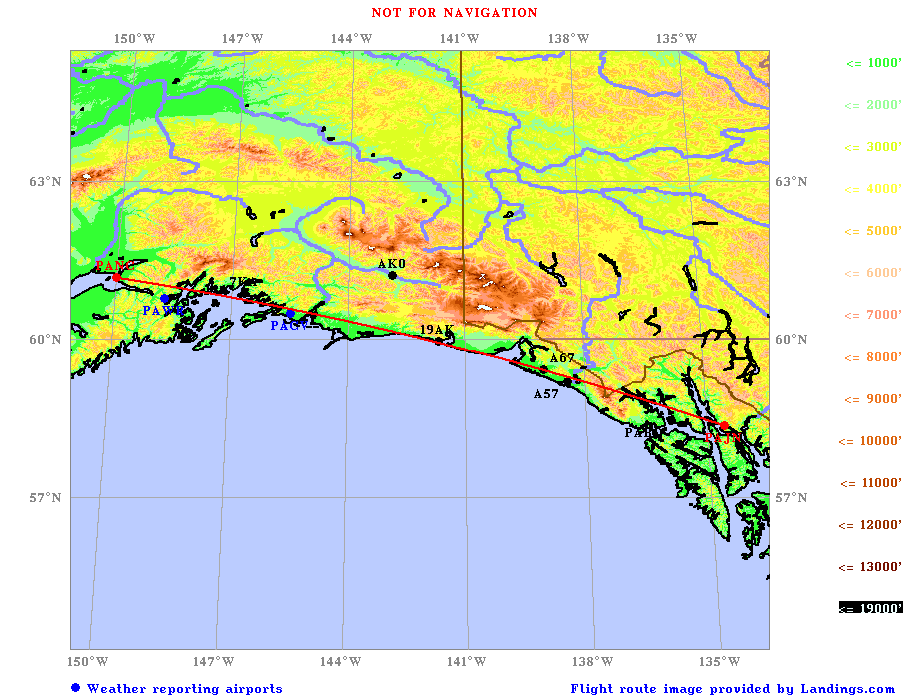

It was bright morning at 5 a.m. when I arose. I grabbed a quick bite to eat and was ready for take off before six. Weather at Juneau looked tolerable, low overcast with the ceiling at 800 feet. Way okay for commercial airliners, but I wasnít a commercial airliner. It wasnít supposed to get any worse, and if it did I had the legs to turn around and make it back to Anchorage. I decided to go.
The flight followed the coast almost the entire way. As soon as I was at altitude I could see the mountains looming ahead. These are 20,000 foot mountains that seem to rise straight from the ocean, covered with glaciers. It was almost surreal, like a backdrop painted for a movie and not something that could really be. They kept getting bigger as I got closer. I flew over Glacier Bay and saw the glacier calving large blocks of ice into the bay. Just south of Glacier Bay I started seeing the fog which typically hangs over the coast. Ahead was a white blanket stretching from the mountains and out over the sea.
Clouds are very important to small plane aviators. Big commercial jets fly right through them and on up to clear air. Little planes just canít do that. And even commercial jets avoid thunderstorms since they can bring down even the biggest jet. I knew a former Air Force pilot whose F-4 got hit by lightning. It took a foot off the top of the tail, blew out every electrical system on the plane, and damn near crashed him. Not long ago a jumbo jet on the way from Brasil to France hit one of those storms in mid Atlantic and it tore the control surfaces right off the plane. That's a long fall from 40,000 feet into the ocean. Clouds hide danger.
I was flying IFR, under the direction of ATC. They had me descend until I was level at 5,000 feet and passed me to Juneau approach. I was down in the fog now and couldnít see a thing except the white haze and water running off the wind screen. I had flown lots of approaches for my IFR rating under the hood. But this was different. When you fly under the hood there is an instructor sitting next to you and he can see. I was flying blind and into an airport I had never flown into before, that had mountains on both sides. It was unnerving. I just kept my eyes on the glide path and followed that baby like it was the path to a pot of gold. One nice thing, if the ATC ran me into a mountain at 250 knots, it would be over before I even knew I was in trouble. I kept an eye on the altitude. At 900 feet I started to see breaks and at 800 feet I was in the clear. The runway was in front of me, hills on both sides and the city off to the left. Man, that runway looked beautiful. Now, it was just as easy to land visually. I dropped the gear and flaps and set everything for landing. I gave it a touch of throttle, preferring to land down further than undershoot. I had plenty of runway to work with. I bounced it a little, to my chagrin, but it was a good landing: I could walk away.
As I taxied I made a call on UNICOM for avgas. In the terminal I found the pilot phone and called 1-800-WXBRIEF and checked the weather for the next leg to Sacramento. Sacramento was clear and predicted clear for days. In the summer when I planned this trip I had decided never to fly for too long a time. The longest trips had been necessary because I had to get across oceans. The trip planner called for me to overnight here in Juneau.
The problem was that I was itchy now that I was so close to home. I had done that double hop day in Australia and I would be flying in familiar space the last part of the trip. I convinced myself and decided to do a quick turn and make it a long haul. It would be a long day but damn, I could sleep in my own bed tonight. That was worth whatever it took to get home. I went back out on the ramp and the gas truck met me and topped up the tanks. Now I could make that last long hop and be home.
I called back and filed a flight plan from Juneau to Sacramento since I would be traveling across the ADIZ I didn't want anyone to think I was a Russian or worse, a terrorist.
Return to Around the World homepage
Copyright Rod O'Steele © 2008, 2013